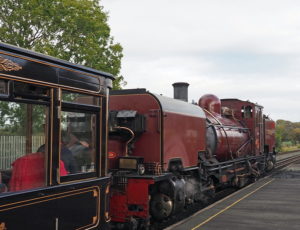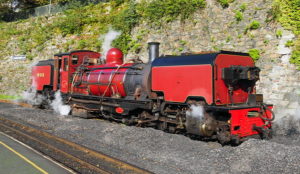With the rapid development of the slate industry in North Wales, a series of narrow gauge railways were built to carry slate from the quarries to sailing ships for transport around the world.
The C19th saw the rapid growth of standard gauge railways in North Wales. Following the success of the Ffestiniog Railway (FR), Charles Spooner conceived the idea of a series of narrow gauge branch lines, known as the North Wales Narrow Gauge Railways (NWNGR) to serve smaller settlements and quarries in North Wales. In 1881, a narrow gauge railway was opened from Dinas Junction on the Caernarfon to Pwhelli line to Rhyd Ddu at the foot of Snowdon, with a short branch line to the Bryngwyn slate quarries. At the time this was the closest railway to Snowdon, so it was heavily promoted as a tourist ride.
In 1901, another narrow gauge railway, the Portmadoc, Beddgelert & South Snowdon Railway (PBSSR) was proposed to take over the route of the Croesor Tramway from Porthmadog to Beddgelert and then to a newly constructed hydro electric station in Nant Gwynant. This also served the South Snowdon slate quarry. Construction started in the Aberglaslyn Pass in 1905 with plans to build as far as Beddgelert and South Snowdon. Money ran out and construction came to an end leaving the Aberglaslyn tunnels and other abandoned earthworks. The Croesor tramway continued to bring slate down from the Croesor valley.
In 1914 local authorities promoted a light railway order to take over the NWNGR and PBSSR and complete a link between the two. Now known as the Welsh Highland Railway (WHR), the completed line opened in 1923. There was never enough traffic to justify the railway and despite marketing attempts to promote it as a circular tour, it never made a profit and was unable to pay off its loans. By 1924 passenger traffic just ran for a few months in the summer and good traffic on demand. The slate industry was in decline and tourists preferred the convenience of the motor bus.
After a relatively good season in 1933, the Ffestiniog Railway put forward a plan to run both railways and signed a 42 year lease on the WHR. Traffic decreased even further and the last passenger train ran in September 1937. All traffic was suspended from June 1937.
During the Second World war. much of the railway’s equipment was requisitioned for the war effort.
Following the success of restoring the Ffestiniog Railway from 1954, the Welsh Highland Light Railway (1964) Co Ltd was set up from a base at Gelert’s Farm and ran along a short stretch of track alongside the Cambrian Coast Main Line, known as Beddgelert Siding. They had ambitious plans to rebuild the railway, which came to nothing as they were unable to gain access to the old trackbed which was in the hands of the Official Receiver.
In 1989 the FR made a bid to acquire the WHR trackbed from the Official Receiver, with plans to rebuild the WHR from Caernarfon to Porthmadog. Following several years of heated argument between the FR and 1964 Company, a High Court hearing, three public inquiries, an appeal, the Secretary of State granted the FR permission to rebuild the WHR.
Work began in 1997 from Caernarfon. The 1964 Company reached an agreement with the FR to rebuild the railway to Pont Croesor and to operate trains on this section, until it was required for completing the route to Harbour Station. They began work but it was hampered by the foot and mouth outbreak in 2001 and work came to a stop. The 1964 Company is now rebranded as the “Welsh Highland Heritage Railway”:https://www.whr.co.uk/ and runs from its station near Network Rail’s Porthmadog Station along 1 mile of track to Pen y Mount where it connects to the WHR.
The WHR eventually reached Porthmadog Harbour station in 2011.
Over the years we have “travelled”:https://www.silvertraveladvisor.com/review/attraction/152216-review-welsh-highland-railways different sections of the line but never done it in full.
It was time to remedy that and I booked a return ticket for the full line. This isn’t cheap at £41.50 for the round trip but if you have a child under 16, they get free travel with one fare paying adult.
In October there were just two trains running. I caught the train from Porthmadog which gave me just over an hour in Caernarfon before returning to Porthmadog. The line is 25 miles long and is the longest preserved steam railway in Britain. The trip takes around two and a quarter hours one way.
It was a beautiful morning so I decided to be brave and sit in the “open coach”:https://www.festipedia.org.uk/wiki/Carriage_2020#/media/File:PNJ20110212_Carr_2020_Minffordd_Slide_KL151.jpg at the end of the train. While this has a roof, there is no glass in the windows, making it great for taking pictures. It also means there is no shelter from the elements and seats are wooden benches. On a warm sunny day it is great fun. It was sunny in Porthmadog and at Caernarfon, but as we ran through the mountains of Snowdonia, the cloud was down on the tops and it was decidedly ‘atmospheric’.
The coach was at the back of the train so gave good views of the train as the line snaked round curves. However on the return trip I was a wimp and sat in a “‘normal’ coach.”:https://www.festipedia.org.uk/wiki/Carriage_2043#/media/File:2043RhydDdu.jpg
I came back with dozens of pictures, which form a series of reviews describing the different sections of the trip.
“Brocure and map”:https://festrail.co.uk/pdf/whr_timetable_2019.pdf of the route
There is information about disabled access “here.”:https://www.silvertraveladvisor.com/review/attraction/152884-review-welsh-highland-railways









